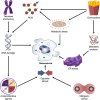Cellular Senescence as a Therapeutic Target for Age-Related Diseases: A Review
- PMID: 32185730
- PMCID: PMC7140757
- DOI: 10.1007/s12325-020-01287-0
Cellular Senescence as a Therapeutic Target for Age-Related Diseases: A Review
Abstract
Life expectancy has increased substantially over the last few decades, leading to a worldwide increase in the prevalence and burden of aging-associated diseases. Recent evidence has proven that cellular senescence contributes substantially to the development of these disorders. Cellular senescence is a state of cell cycle arrest with suppressed apoptosis and concomitant secretion of multiple bioactive factors (the senescence-associated secretory phenotype-SASP) that plays a physiological role in embryonic development and healing processes. However, DNA damage and oxidative stress that occur during aging cause the accumulation of senescent cells, which through their SASP bring about deleterious effects on multiple organ and systemic functions. Ablation of senescent cells through genetic or pharmacological means leads to improved life span and health span in animal models, and preliminary evidence suggests it may also have a positive impact on human health. Thus, strategies to reduce or eliminate the burden of senescent cells or their products have the potential to impact multiple clinical outcomes with a single intervention. In this review, we touch upon the basics of cell senescence and summarize the current state of development of therapies against cell senescence for human use.
Keywords: Aging; Non-communicable diseases; Senescence; Senolytics; Therapeutics.
Figures






References
-
- Roser M, Ortiz-Ospina E, Ritchie H. Life expectancy. OurWorldInData.org. 2020. https://ourworldindata.org/life-expectancy. Accessed 19 Feb 2020.
-
- Mason A, Lee R, Abrigo M, Lee SH. Support ratios and demographic dividens: estimates for the world. United Nations, Department of Economic and Social Affairs, Population Division. Technical paper no. 2017/1. New York; 2017.
-
- World Health Organization. World health statistics overview 2019: monitoring health for SDG, sustainable development goals. License: CC BY-NC-SA 3.0 IGO. Geneva; 2019.
-
- World Health Organization. Global health observatory (GHO) data, top 10 cases of death. https://www.who.int/gho/mortality_burden_disease/causes_death/top_10/en/. Accessed 10 Jan 2020.
-
- Institute for Health and Evaluation (IHME) Findings from the global burden of disease study 2017. Seattle: IHME; 2018.
Publication types
MeSH terms
LinkOut - more resources
Full Text Sources

